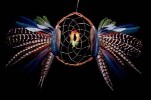^*^*^*^*^*^*^*^*^*^*^*^*^*^*^*^*^*^*^*^*^*^*^*^*^*^*^*^*^*^
| Humor : Gifts |
| Adam and Eve are relaxing in the Garden of Eden when God appears. He tells them that he has brought a gift for each of them. He shows them the first gift, which is a penis, and explains to them that they can pee standing up, no more squatting on the ground. Adam is so excited, he starts begging Eve to please let him have this gift. Eve agrees, and Adam starts running around the garden peeing on every tree and bush in sight.
God says, "Well Eve, I guess this gift is yours. It's a brain.
|
^*^*^*^*^*^*^*^*^*^*^*^*^*^*^*^*^*^*^*^*^*^*^*^*^*^*^*^*^*^
Who's Who in World Mythology : Aganju
For past articles and the bibliography, please go to the
Who's Who Archive.
In Yoruba myth, Aganju is the Orixa (god) of volcanoes. He is the son of Orishako and Obdudua (Oro Ainu), the dread fire which he controls. As Lord of Caves, he owns all the mineral wealth of the earth and can be appealed to part with some. He also acts as the god of untamed lands, from deserts to mountains and is the navigator, knowing the safe passages and fords across rivers. For this reason, the followers of Santeria equate him with St. Christopher.
Aganju is the brother/husband of Yemaja (Iemanja), and he is the father of most of the Orixa, including Orunjan, Ogun, Oko, Olokun, Shango, shankpanna, the sun, the moon, and several river goddesses. He is also the father of Xango, though Xango was raised by Oxala. He was once the King, but his drunkenness led to his disposition by his son Xango (though there are some conflicting ideas as to whether he was deposed or abdicated).
His patterns consists of nine beads: two brown, one red, one yellow, one blue, one yellow, one red, two brown is one pattern. He likes offerings of beer and beef. He may try to eat the beer bottles however. It's one of his favorite tricks. Mediums carrying Aganju may well try and eat glass as well. He also likes to jump.
^*^*^*^*^*^*^*^*^*^*^*^*^*^*^*^*^*^*^*^*^*^*^*^*^*^*^*^*^*^
| Quote: Thomas Huxley |
Every great advance in natural knowledge
has involved the absolute rejection of authority. |
^*^*^*^*^*^*^*^*^*^*^*^*^*^*^*^*^*^*^*^*^*^*^*^*^*^*^*^*^*^
The Magi's Garden: Carob
For past featured foliage and the bibliography, please go to the
The Magi's Garden Archive.
Carob (Ceratonia siliqua; related species- Jacaranda procera)

Folk Names: Algarroba, Caaroba, Caroba, Carobinha, Chocolate, Egyptian Fig, John's Bread, Locust Bean, Locust Pods, Sugar pods
Description: Carob is an evergreen tree of the legume family, which can grow up to fifty feet. It is native to the eastern Mediterranean, probably the Middle East, but it grows well anywhere that citrus is grown and prefers dry climates that receive more than 30 centimeters of rainfall. The pinnately compound leaves have two to six pairs of oval leaflets. It produces no fruit until its fifteenth year, but then will continue to produce fruit well into its old age. The dark-brown fruit of carob is a pod, technically a legume up to a foot long and fairly thick and broad. Most carob trees are monoecious, with individual male and female trees. The pods and seeds are edible, rich in sugars, protein, and vitamin A, B vitamins, and several important minerals. The pods contain four series of oval holes, each bearing a seed like a watermelon seed. Each pod can contain up to 15 seeds. Carob bean, seeds and pods are edible.
Effects:
Planet: Jupiter, Saturn
Element:
Associated Deities:
Traditions:
Carob is believed to have been in cultivation for at least 5000 years. Ancient Egyptians used the gummy properties of carob seed as an adhesive in binding mummies, and the pods and seeds have been found in Egyptian tombs. The Romans are said to have eaten the pods green for their natural sweetness. The ancient Greeks knew this tree as well and planted it in Greece and Italy. There are references to carob in the Bible, and the name, St. John's bread or locust bean, came from the belief that the pods were the "locusts" eaten by John the Baptist in the Wilderness (though the story is apparently wrong--he ate migratory locust).
Seeds were used to weight gold, hence the word "carat" from which the name Carob evolved. Mohammed's army ate kharoub, and Arabs planted the crop in northern Africa and Spain. Spaniards carried carob to Mexico and South America, and the British took carob to India, Australia and to South America, though the Chiriguano tribe of South America say the tree came from Aguara-Tunpa, a fox deity.
Records show that carob was intentionally introduced into the United States in 1854, and the first seedlings were planted in California in 1873.
Magic:
Carob beans may be carried or worn to bolster the health and to guard against evil. It is believed anyone who carries a seedpod will be blessed with great wealth; something to think about if you’re planning a trip to the casinos.
Known Combinations:
none noted
Medical Indications: Parts Used:
Singers believe that chewing the pod will clear up a rough voice.
Nutrition:
Though the pods are used as livestock feed, we know carob mostly as a cocoa substitute. It has a slightly different taste than chocolate, but it has only one-third the calories, is virtually fat-free, is rich in pectin, and has abundant protein. Not only does it have no oxalic acid (which interferes with absorption of calcium), but it a non-allergenic alternative to chocolate. Consequently, carob flour is widely used in health foods for chocolate-like flavoring. Carob is also used as a food stabilizer and food coloring.
Mercantile Uses:
This species is grown around the world primarily as a food crop, for its sweet and nutritious fruits. For commercial production cultivars with the finest quality fruits are bud grafted on common stock.
Though it is grown in California, Florida, and parts of the South, most carob used in America comes from the Mediterranean Region, especially Sicily, Cyprus, Malta, Spain, southern Sardinia, and Italy along the Adriatic Sea.
^*^*^*^*^*^*^*^*^*^*^*^*^*^*^*^*^*^*^*^*^*^*^*^*^*^*^*^*^*^
Cartoon

^*^*^*^*^*^*^*^*^*^*^*^*^*^*^*^*^*^*^*^*^*^*^*^*^*^*^*^*^*^
Poem : Invictus
William Ernest Henley (1839-1903)
Out of the night that covers me,
Black as the Pit from pole to pole,
I thank whatever gods may be
For my unconquerable soul.
In fell clutches of circumstance
I have not winced nor cried aloud.
Under the bludgeonings of chance
My head is bloody, but unbowed.
Beyond this place of wrath and tears
Looms but the horror of the shade,
And yet the menace of the years
Finds, and shall find me, unafraid.
It matters not how strait the gate,
How changed with punishments the scroll,
I am master of my fate;
I am captain of my soul.
^*^*^*^*^*^*^*^*^*^*^*^*^*^*^*^*^*^*^*^*^*^*^*^*^*^*^*^*^*^
| Quote : Zen saying |
| The infinite is in the finite of every instant. |
^*^*^*^*^*^*^*^*^*^*^*^*^*^*^*^*^*^*^*^*^*^*^*^*^*^*^*^*^*^
The Power of Stones: Beryllonite
For past articles and the bibliography, please go to the
Power of Stones Archive.

Beryllonite is colorless, white, or yellow. It encourages a pleasant disposition and relieves anxiety in regards to how others view your activities. Similarities are emphasized over differences. Beryllonite also relieves fatigue.
^*^*^*^*^*^*^*^*^*^*^*^*^*^*^*^*^*^*^*^*^*^*^*^*^*^*^*^*^*^
| Humor : My Wife is Poisoning Me! |
| A man goes to see his rabbi about a problem he is having. "Something terrible is happening and I have to talk to you about it," says the man.
"What's the matter?" asks the rabbi, sensing that there is a serious problem.
"My wife is poisoning me!" exclaims the man.
Stunned, the rabbi asks, "How can that be?"
"I'm telling you that I'm certain that she's poisoning me," replies the man.
The rabbi puts his hand on the man to comfort him and says, "Let me talk to her. I'll see what I can find out and let you know."
A week later the Rabbi calls the man. "Well I spoke to your wife. I called her on the phone and spoke to her for four hours. Would you like my advice?"
"Yes, please," begs the man.
The rabbi pauses then says, "Take the poison." |
^*^*^*^*^*^*^*^*^*^*^*^*^*^*^*^*^*^*^*^*^*^*^*^*^*^*^*^*^*^
A Dreamer's Guide : Music to Myth
For past articles and the bibliography, please go to the
Dreamer's Guide Archive.
Beautiful, harmonious Music means good fortune for some idea which concerns you deeply. If it was at a concert, you will receive some money, while if it was at the theater, you will be consoled in your misfortune. If the music was in any way unpleasant, it is a forecast of discord in your business or personal life. You will be very uncomfortable if you heard jazz, but opera or singing augurs very welcome news.
Avoid rivals if you dreamt of a Music Box. If it played your favorite song, you will soon have a change of surroundings. Danger in love is foretold if you put any money in a music box.
A Music Hall means all your affairs will prosper. If you went alone, pleasant news will come from an absent friend, while attending with a loved one foretells a renewal of an old friendship. You will do a cunning and underhanded thing if you attended with family.
A sudden surprising change in your life is indicated if you could play a Musical Instrument which you cannot normally play in the waking world. If you saw a broken instrument, it is a warning about your health. If you broke a string on an instrument, it is a sign of broken love, but if you restrung an instrument, you will receive good news. Carrying a musical instrument is an omen of good luck with the opposite sex.
You will become inebriated if you dreamt of Musicians. There will be sudden changes in your life if you were a musician, and if you were professional, you may soon move. You will become engaged if you were a beginner.
The smell of Musk presages a passionate new love affair, either for you or someone close.
A Musket predicts the receipt of a passionate love letter. Honor and joy are foretold by many soldiers bearing muskets. You have many enemies within your family if you saw an empty musket, while a loaded musket predicts financial gain. Loss of profit is augured if you fired a musket.
Mussels predict luck and prosperity. Contentment is the interpretation given for gathering mussels, and buying them means someone will tender you a proposal. You will change to a better position if you bought them in a can. You will come out well through your present danger if you gave mussels to others. Cooking mussels indicates the failure of your enemies. If you ate them, you will find yourself increasingly more popular through your work.
A Mustache is a warning not to let small irritations turn into large heartaches. Shaving a mustache off is forerunner of an unhappy sexual experience followed by new love. A big mustache foretells an increase in fortune, while the opposite can be augured from a small one. An ugly mustache indicates public disgrace.
Mustard signifies good news and prosperity so long as you do not act in haste. You will repent your actions if you ate it, and if your relatives ate it, there is danger in speaking too freely. Avoid sharing secrets if your friends were eating it, and eating cooked mustard greens augurs a lavish waste of fortune and mental strain. Eating mustard greens fresh from the garden is a sign that you will sacrifice wealth for personal satisfaction. Cooking with mustard signifies troubles, and bad luck is suggested by powdered mustard. If mustard was on the table, you will have arguments and disputes. Beware of false friends if you bought mustard.
If you tried to converse with a Mute, the unusual burdens of yourself will uniquely suit you to a higher position you will be offered. If you were mute, you will experience misfortune and unjust persecution.
If you Mutilated something, you will triumph over enemies. You financial plans are good if you mutilated yourself. Avoid rivals if your leg was mutilated, and if it was your arm, your friends are dishonest. You will recover money if your hand was mutilated, and you will recover from illness if your foot was.
Mutiny is a warning of untrue friends. If you watched a mutiny, be cautious in business, and if you took part in it, you are unhappy in your current position. Infidelity is indicated if you were wounded in a mutiny. If you overcame a mutiny, you will advance in your position.
Happiness in love is augured if you put a Muzzle on a dog, and putting a muzzle on any other creature means your enemies are under control.
If you were Myopic, you are being watched by someone with evil intent, but if children were nearsighted, good times are coming. Friends will cheat you if anyone else suffered from myopia. Your enemies will fail to do you harm however if you got glasses to fix your nearsightedness.
Your investments will give you satisfaction if you dreamt of Myrrh. Perhaps you will make a new and wealthy acquaintance.
Myrtle indicates both popularity and sexual energy. Myrtle blossoms mean you will obtain the pleasures you desire. If you picked myrtle branches, you will have luck and prosperity. Wearing a sprig augurs a marriage to a well-to-do and intelligent mate. Withered myrtle is a sign of missed happiness through careless conduct.
If you were aware of some Mystery you are being admonished that your worries are self-induced. If you can relax, they will disappear. If some mystery was explained to you, avoid your rivals. Your friends are loyal if you dreamed of hearing about some mystery. You will suffer through your own foolishness if you had mysterious friends.
Any dream featuring elements or beings of Myth is telling you that flattery will get your everywhere, so start laying it on thick.
^*^*^*^*^*^*^*^*^*^*^*^*^*^*^*^*^*^*^*^*^*^*^*^*^*^*^*^*^*^
| Quote : Malcolm X |
A man curses because he doesn't have the words
to say what's on his mind. |
^*^*^*^*^*^*^*^*^*^*^*^*^*^*^*^*^*^*^*^*^*^*^*^*^*^*^*^*^*^
Ancient Whispers Newsletter Archive
Past Newsletters

 The 15th day of the first moon is the 'Chunga Choepa' or the Tibetan Butter Lamp Festival, the climax of their New Year celebrations. Huge 'Tormas' are sculpted from butter in the form of various auspicious symbols and lamps. This was once the highlight of 'Monlam' in Lhasa, the Prayer Festival held from the 4th to the 11th day of the 1st lunar month. The Dalai Lamas would come to the Jokhang Temple and perform the great Buddhist service. The question and answer test for the highest-ranking monk of 'Lharampa Geshe' was held before the Dalai Lama during this festival. These events are now carried out in Dharamsala however where the Dalai Lama's government is in exile.
The 15th day of the first moon is the 'Chunga Choepa' or the Tibetan Butter Lamp Festival, the climax of their New Year celebrations. Huge 'Tormas' are sculpted from butter in the form of various auspicious symbols and lamps. This was once the highlight of 'Monlam' in Lhasa, the Prayer Festival held from the 4th to the 11th day of the 1st lunar month. The Dalai Lamas would come to the Jokhang Temple and perform the great Buddhist service. The question and answer test for the highest-ranking monk of 'Lharampa Geshe' was held before the Dalai Lama during this festival. These events are now carried out in Dharamsala however where the Dalai Lama's government is in exile.
 Festival of Peace
Festival of Peace
 Mahatma Gandhi
Mahatma Gandhi

 The Valkyries and the Norns; Feast of Soldag
The Valkyries and the Norns; Feast of Soldag
 With the new crescent moon, the Hopi and the Pueblo people hold their Powamu festival. Beans are planted in kivas, large buildings used for religious rituals. As many as two hundred Kachina dancers will perform rituals while the beans grow to ensure a good crop, but Eototo is the chief of all Kachinas and controls the seasons. He is the spiritual counterpart of the village chief and is called father of the Kachinas. During the Bean Dance of the Third Mesa, he conducts an elaborate ceremony by drawing cloud symbols in corn flour. Aholi (Eototo's reinforcer) places his staff in the center of the symbols and waves it in an all-encompassing fashion, while giving out a long call. This dance is designed to draw the clouds and moisture to the pueblo. Children between the ages of six and ten are initiated into their Kachina societies, receiving gifts from the dancers.
With the new crescent moon, the Hopi and the Pueblo people hold their Powamu festival. Beans are planted in kivas, large buildings used for religious rituals. As many as two hundred Kachina dancers will perform rituals while the beans grow to ensure a good crop, but Eototo is the chief of all Kachinas and controls the seasons. He is the spiritual counterpart of the village chief and is called father of the Kachinas. During the Bean Dance of the Third Mesa, he conducts an elaborate ceremony by drawing cloud symbols in corn flour. Aholi (Eototo's reinforcer) places his staff in the center of the symbols and waves it in an all-encompassing fashion, while giving out a long call. This dance is designed to draw the clouds and moisture to the pueblo. Children between the ages of six and ten are initiated into their Kachina societies, receiving gifts from the dancers.
 The 19th day of the first moon is the Rats' Wedding in China. The day honors household rats in order to propitiate them. Salt and grains of rice are sprinkled inside the home to share fortune with the rats.
The 19th day of the first moon is the Rats' Wedding in China. The day honors household rats in order to propitiate them. Salt and grains of rice are sprinkled inside the home to share fortune with the rats.
 Feast of Nut
Feast of Nut
 fair of the Frost King
fair of the Frost King


